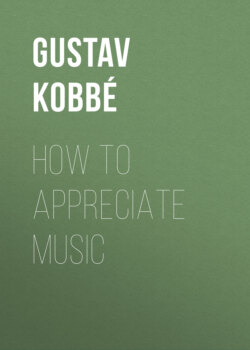Читать книгу How to Appreciate Music - Gustav Kobbé - Страница 19
На сайте Литреса книга снята с продажи.
Harmony and Counterpoint.
ОглавлениеA melody or theme is a rational progression of single tones. Here is the melody or theme with which Beethoven begins the familiar “Moonlight Sonata”:
Beethoven’s “Moonlight Sonata” [Listen]
It is a melody, but it does not constitute harmony, for harmony is the rational combination of several tones, as distinguished from the rational progression of single tones which constitute melody. But when Beethoven adds an accompaniment to his theme and it becomes:
Beethoven’s “Moonlight Sonata” [Listen]
53
the passage also becomes harmony, since it is an example of the rational combination of several tones. As has often been pointed out in books on music, and probably often will have to be pointed out again, because as a mistake it is to be classed with the hardy perennials, melody is not harmony, but only a part of it. When, however, a composer conceives a theme or melody he usually does so with the purpose of combining it with an accompaniment that shall support it and throw it into bold and striking relief. Composers of the contrapuntal school, on the other hand, conceived a theme, not for the purpose of supporting it with an accompaniment, but in order to combine it with another or with several other equally important themes. That, in a general way, is the difference between harmony and counterpoint.
In harmony, then, or, more strictly speaking, in music composed according to the harmonic system, of which the “Moonlight Sonata” is a good example, the theme, the melody, stands out from the accompaniment, which is subordinate. Counterpoint, on the other hand, rests on the combination of several themes, each of equal importance. This is the reason why, when there is a fugue or other complicated contrapuntal work on the program of a pianoforte recital, the average listener is apt to find it dry and uninteresting. His ear readily can distinguish the themes of a sonata, which usually are heard one at a time and stand out clearly from the accompaniment, but it has not been trained to unravel the themes of the fugue as they travel along together. Counterpoint, the term being derived from the Latin contra punctum, which means point against point or 54 note against note, when complicated, as in a fugue, is about the most elaborate kind of music there is, and a person who is unable to grasp a fugue may console himself with the thought that, excepting for the elect, it is a pretty stiff dose to swallow at the very beginning of a recital.
There are, however, simpler pieces of counterpoint than a fugue. Sometimes, as in the charming little “Gavotte” by Padre Martini, which now and then figures among the lighter numbers on the programs of historical recitals, the contrapuntist combines a theme with itself, or, rather, “imitates” it, which is a simple form of the canon. Another form of canon is the round of which “Three Blind Mice” is a familiar example. How many people, when singing this, have realized that they were being initiated into that mysterious thing known as counterpoint? A comparatively simple form of counterpoint is well illustrated by a dapper little piece in Bach’s “Two-Part Inventions,” in which the spirited theme given out by the right hand answers itself a bar later in the left, an “imitation” which crops out again and again in the piece and gives it somewhat the character of a canon.
[Listen]
For any one who wishes to become acquainted with 55 Bach there is nothing better than these “Two-Part Inventions,” especially the fascinating little piece from which I have just quoted, compact, buoyant and gay, even “pert,” as I once heard a young girl characterize it; a perfect example of old Father Bach in moments of relaxation when he has laid aside his periwig and is amusing himself at his clavichord.
